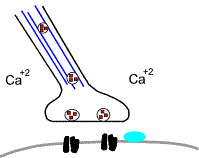CIDPUSA.org Autoimmune diseases
about nerve function
Nerve physiology
Axonal Polyneuropathy changes in EMGEMG/NCV section
Learn about the Brain
Learn about nerves
Nerve Fibers conduction described in detail below.
Nerve Physiology Handbook
When an impulse arrives at the end bulb, the end bulb membrane becomes more permeable to calcium. Calcium diffuses into the end bulb & activates enzymes that cause the synaptic vesicles to move toward the synaptic cleft. Some vesicles fuse with the membrane and release their neurotransmitter (a good example of exocytosis). The neurotransmitter molecules diffuse across the cleft and fit into receptor sites in the postsynaptic membrane. When these sites are filled, sodium channels (also called, as in the figure above, chemically gated ion channels) open & permit an inward diffusion of sodium ions. This, of course, causes the membrane potential to become less negative (or, in other words, to approach the threshold potential). If enough neurotransmitter is released, and enough sodium channels are opened, then the membrane potential will reach threshold. If so, an action potential occurs and spreads along the membrane of the post-synaptic neuron (in other words, the impulse will be transmitted). Of course, if insufficient neurotransmitter is released, the impulse will not be transmitted.

Source:
This describes what happens when an 'excitatory' neurotransmitter is released
at a synapse. However, not all neurotransmitters are 'excitatory':
Types of neurotransmitters:
1- Excitatory - neurotransmitters that make membrane potential less negative
(via increased permeability of the membrane to sodium) &, therefore, tend to
'excite' or stimulate the postsynaptic membrane
2 - Inhibitory - neurotransmitters that make membrane potential more
negative (via increased permeability of the membrane to potassium) &,
therefore, tend to 'inhibit' (or make less likely) the transmission of an
impulse. One example of an inhibitory neurotransmitter is gamma aminobutyric
acid (GABA; shown below). Medically gamma aminobutyric
acid GABA has been used to treat both
epilepsy and hypertension. Another example of an inhibitory neurotransmitter
is beta-endorphin, which results in decreased pain perception by the CNS.
Links:
CIDPUSA.ORG
B-12 deficiency
Small Fiber neuropathy
neurological effects of CIDP
Nerve Fiber types
CIDP-EMG
Multi Focal Motor neuropathy
Lewis Summer
Tips for CIDP
Plasmapheresis
CIDP-INFO
CIDP-Rituxan
CIDP-GBS-Handbook
CIDP-family issue
CIDP-Cyclosporin
Polyneuropathy
CIDP-GBS children
Peripheral Neuropathy
ALS & CIDP
alcoholic poly neuropathy
IVIg, Home to IVIg